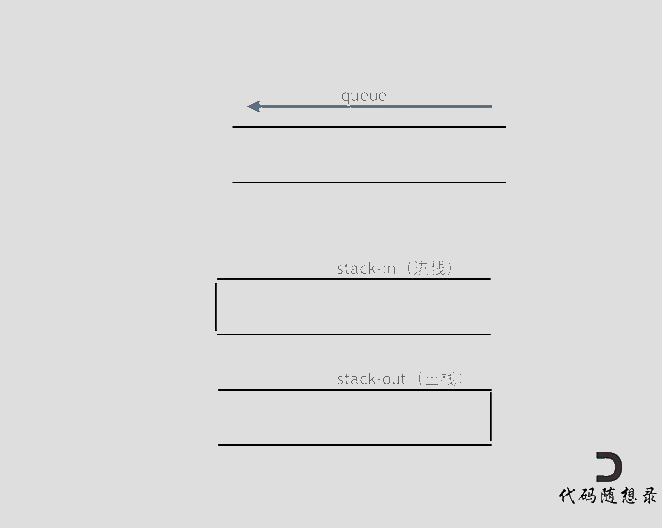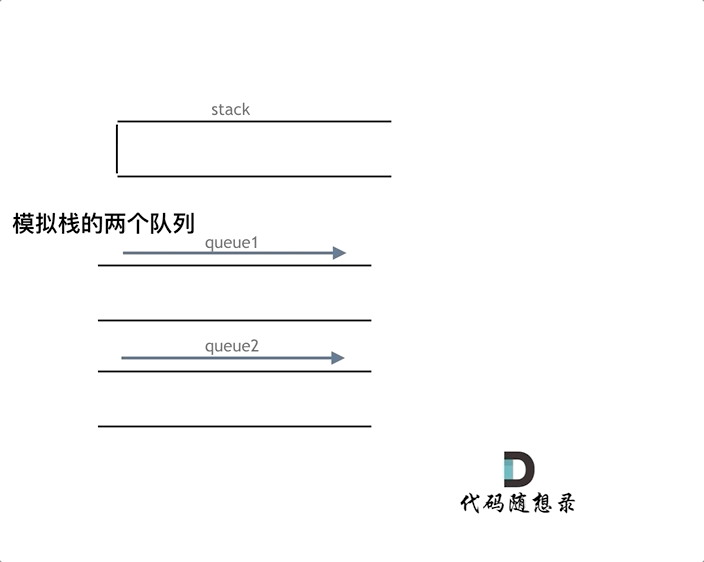今天学习了栈和队列的第一部分。
- 基础知识
- 用栈模拟队列(双栈)
- 用队列模拟栈(一个队列,但是需要重复将队头元素写到队尾)
- 栈的基本应用(括号匹配、删除重复项、逆波兰表达式)
1. 基础知识
- 栈和队列是以底层容器完成其所有的工作,对外提供统一的接口,底层容器是可插拔的(也就是我们可以控制使用哪种容器来实现栈的功能)。
- 栈队列的底层实现可以是
vector,deque,list, 主要就是数组和链表的底层实现。 - 所以
STL栈和队列也不被归类为容器,而被归类为container adapter( 容器适配器)。 SGI STL中 栈和队列底层实现缺省情况下使用deque实现。deque是一个双向队列,只要封住一段,只开通另一端就可以实现栈的逻辑了。
2. 用栈实现队列(双栈)
题目:请你仅使用两个栈实现先入先出队列。队列应当支持一般队列支持的所有操作(push、pop、peek、empty):
实现 MyQueue 类:
void push(int x)将元素 x 推到队列的末尾int pop()从队列的开头移除并返回元素int peek()返回队列开头的元素boolean empty()如果队列为空,返回true;否则,返回false
队列是两头进出,所以一个栈做不到,至少需要两个栈。一个输入栈,一个输出栈,这里要注意输入栈和输出栈的关系。

- push:只要数据放进输入栈就好
- pop:输出栈如果为空,就把进栈数据全部导入进来,再从出栈弹出数据;如果输出栈不为空,则直接从出栈弹出数据就可以了
- peek:复用pop
int res = this->pop();
class MyQueue {
public:
stack<int> stIn;
stack<int> stOut;
/** Initialize your data structure here. */
MyQueue() {
}
/** Push element x to the back of queue. */
void push(int x) {
stIn.push(x);
}
/** Removes the element from in front of queue and returns that element. */
int pop() {
// 只有当stOut为空的时候,再从stIn里导入数据(导入stIn全部数据)
if (stOut.empty()) {
// 从stIn导入数据直到stIn为空
while(!stIn.empty()) {
stOut.push(stIn.top());
stIn.pop();
}
}
int result = stOut.top();
stOut.pop();
return result;
}
/** Get the front element. */
int peek() {
int res = this->pop(); // 直接使用已有的pop函数
stOut.push(res); // 因为pop函数弹出了元素res,所以再添加回去
return res;
}
/** Returns whether the queue is empty. */
bool empty() {
return stIn.empty() && stOut.empty();
}
};
- 时间复杂度: push和empty为O(1), pop和peek为O(n)
- 空间复杂度: O(n)
3. 用队列模拟栈
题目:使用队列实现栈的下列操作:
- push(x) -- 元素 x 入栈
- pop() -- 移除栈顶元素
- top() -- 获取栈顶元素
- empty() -- 返回栈是否为空
a. 两个队列来实现栈
队列是先进先出的规则,把一个队列中的数据导入另一个队列中,数据的顺序并没有变,并没有变成先进后出的顺序,因此和上一题一样的思路不可行。
但是依然还是要用两个队列来模拟栈,只不过没有输入和输出的关系,而是另一个队列完全用来备份。如动画所示,把que1最后面的元素以外的元素都备份到que2,然后弹出最后面的元素,再把其他元素从que2导回que1。

b. 使用一个队列实现栈
一个队列在模拟栈弹出元素的时候只要将队列头部的元素(除了最后一个元素外) 重新添加到队列尾部,此时再去弹出元素就是栈的顺序了。
class MyStack {
public:
queue<int> que;
/** Initialize your data structure here. */
MyStack() {
}
/** Push element x onto stack. */
void push(int x) {
que.push(x);
}
/** Removes the element on top of the stack and returns that element. */
int pop() {
int size = que.size();
size--;
while (size--) { // 将队列头部的元素(除了最后一个元素外) 重新添加到队列尾部
que.push(que.front());
que.pop();
}
int result = que.front(); // 此时弹出的元素顺序就是栈的顺序了
que.pop();
return result;
}
/** Get the top element.
** Can not use back() direactly.
*/
int top(){
int size = que.size();
size--;
while (size--){
// 将队列头部的元素(除了最后一个元素外) 重新添加到队列尾部
que.push(que.front());
que.pop();
}
int result = que.front(); // 此时获得的元素就是栈顶的元素了
que.push(que.front()); // 将获取完的元素也重新添加到队列尾部,保证数据结构没有变化
que.pop();
return result;
}
/** Returns whether the stack is empty. */
bool empty() {
return que.empty();
}
};
4. 20有效的括号(栈)
题目:三种括号匹配。
碰到左括号,压入右括号!更好处理
!mystack.empty()&& mystack.top() == s[i]注意,取top之前一定看看是否是空!!
bool isValid(string s) {
int length = s.size();
stack<char> mystack;
for (int i = 0; i < length; i++) {
if (s[i] == '(') mystack.push(')');
else if (s[i] == '[') mystack.push(']');
else if (s[i] == '{') mystack.push('}');
else if (s[i] == ')'||s[i] == ']'||s[i] == '}') {//右括号
if (!mystack.empty()&& mystack.top() == s[i]) {
mystack.pop();
} else
return false; // 错误一:mystack是空,则右括号多;错误二:不匹配
} else
return false; //防止什么奇怪的错误
}
if (mystack.size() == 0) //string s中处理完后,栈中是空的才是完美结束
return true;
else //错误三:栈中不空,说明左括号多
return false;
};
5. 1047. 删除字符串中的所有相邻重复项(栈)
题目:给出由小写字母组成的字符串 S,重复项删除操作会选择两个相邻且相同的字母,并删除它们。在 S 上反复执行重复项删除操作,直到无法继续删除。在完成所有重复项删除操作后返回最终的字符串。答案保证唯一。
- 输入:"abbaca"
- 输出:"ca"
匹配问题常常使用栈。明显和上一题括号,都是栈的典型应用。
string removeDuplicates(string S) {
stack<char> st;
for (char s : S) {
if (st.empty() || s != st.top()) {
st.push(s);
} else {
st.pop(); // s 与 st.top()相等的情况
}
}
string result = "";
while (!st.empty()) { // 将栈中元素放到result字符串汇总
result = st.top() + result;
st.pop();
}
return result;
}
若是拿字符串直接作为栈,省去了栈还要转为字符串的操作:
string removeDuplicates(string S) {
string result;
for(char s : S) {
if(result.empty() || result.back() != s) {
result.push_back(s);
}
else {
result.pop_back();
}
}
return result;
}
- 可以使用栈来辅助做题,也可以直接将字符串作为栈。因为字符串有pop_back、push_back、back等操作。
- 字符串判空可以使用
st.empty(),而不是size。
6. 150逆波兰表达式求值(栈)
题目:给你一个字符串数组 tokens ,表示一个根据 逆波兰表示法 表示的算术表达式。请你计算该表达式。返回一个表示表达式值的整数。
输入:tokens = ["2","1","+","3","*"]
输出:9
解释:该算式转化为常见的中缀算术表达式为:((2 + 1) * 3) = 9
明显的栈的应用题。本题中每一个子表达式要得出一个结果,然后拿这个结果再进行运算,和上一题中删除字符串中的所有相邻重复项类似。遇到操作符就弹出两个进行运算。
使用
long longstring变为int或者long long:
stoi、stollchar*变为int或者long long:
atoistring变为char*:
c_str()数字常量**(int,double,long等)转换为字符串(string):
to_string
int evalRPN(vector<string>& tokens) {
stack<long long> st;
for (int i = 0; i < tokens.size(); i++) {
if (tokens[i] == "+" || tokens[i] == "-" || tokens[i] == "*" || tokens[i] == "/") {
long long num1 = st.top();
st.pop();
long long num2 = st.top();
st.pop();
if (tokens[i] == "+") st.push(num2 + num1);
if (tokens[i] == "-") st.push(num2 - num1);
if (tokens[i] == "*") st.push(num2 * num1);
if (tokens[i] == "/") st.push(num2 / num1);
} else {
st.push(stoll(tokens[i]));
}
}
int result = st.top();
st.pop(); // 把栈里最后一个元素弹出(其实不弹出也没事)
return result;
}
今日古诗
柳梢青·送卢梅坡
刘过〔宋代〕
泛菊杯深,吹梅角远,同在京城。聚散匆匆,云边孤雁,水上浮萍。
教人怎不伤情。觉几度、魂飞梦惊。后夜相思,尘随马去,月逐舟行。